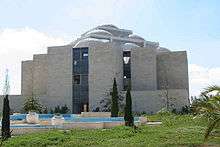Shilo, Mateh Binyamin
Shilo
| ||
|---|---|---|
| Hebrew transcription(s) | ||
| • Translit. | Šîlô | |
| • Also spelled | Shiloh (unofficial) | |
| ||
|
| ||
 Shilo | ||
| Coordinates: 32°3′14″N 35°17′55″E / 32.05389°N 35.29861°ECoordinates: 32°3′14″N 35°17′55″E / 32.05389°N 35.29861°E | ||
| Grid position | 216279/689627 ITM | |
| Region | West Bank | |
| District | Judea and Samaria Area | |
| Founded | 1978 | |
| Government | ||
| • Type | Local council (from 1979) | |
| Population (2015)[1] | ||
| • Total | 3,379 | |
| Name meaning | Shiloh (biblical city) | |
| Website |
shilo | |
Shilo (Hebrew: שִׁלֹה / שילה Šîlô) is a religious communal Israeli settlement in the northern West Bank. Located 28 miles (45 km) north of Jerusalem on Route 60, it is neighboured by the Israeli settlements of Eli and Maale Levona and the Palestinian villages Sinjil, Turmus Ayya and Qaryut, and falls under the jurisdiction of Mateh Binyamin Regional Council. In 2015 it had a population of 3,379.
The international community considers Israeli settlements in the West Bank illegal under international law, but the Israeli government disputes this.[2][3]
Location
The city of Shilo held a central place in the Biblical history of the Jewish people. During the period between capturing the Land and building the Temple, in the days when Joshua divided the land among the 12 tribes, the Tabernacle resided in Shilo. Until the death of Eli the High Priest, Shilo was the place of pilgrimage for the Children of Israel. Three times a year the faithful traveled to Shilo to bring their festival offerings.
Tel Shilo is now an archaeological site, where once the spiritual life of the Jewish people was centered for 369 years in the 11th and 12th centuries BCE. In addition, there are artifacts from other periods, notably the end of the Second Temple (130 B.C.E. – 70 B.C.E.), the Byzantine period (350–618), and the early Muslim period (638–900).[4]
The first archaeological excavations began in 1922–1932 by a Danish expedition. The finds were placed in the Danish National Museum in Copenhagen. In 1980, Yisrael Finkelstein, an archaeologist from Bar-Ilan University, initiated four seasons of digs and many finds were revealed including coins, storage jars, and other artifacts. Many are preserved at Bar-Ilan University. In 1981–1982, Zeev Yeivin and Rabbi Yoel Bin-Nun dug out from the bedrock area of the presumed site of the tabernacle. Ceramics and Egyptian figurines were found. [5]
In the summer of 2010, excavations at Tel Shilo were carried out under the auspices of the Staff Officer for Archeology in the Civilian Administration Antiquities Unit in cooperation with the Mateh Binyamin Regional Council. A portion of the Canaanite period wall from 3700 years ago was uncovered in an attempt to ascertain if this was the first evidence of civilization. One notable find, not far from the wall, was a Roman coin from the period of the Bar Kokhba revolt.[6]
A second season of excavation revealed a large structure, perhaps of an administrative character, originating in the Byzantine period (4th–7th centuries) but built on a Roman period floor.[7][8] An olive press was subsequently uncovered during a cleaning up.
History
According to the Gush Emunim movement, Shilo was considered a potential site for a settlement as early as 1974. In January 1978, a modern community was established adjacent to the ancient biblical site, Tel Shilo. In 1979, Shilo was officially included in the list of settlements under the Jurisdiction of the Settlement Section of the Jewish Agency.[9] The village is administrated by the Mateh Binyamin Regional Council.
The ownership of the land that makes up Shilo is disputed. Settlers and the Israeli government claim that the settlement is built entirely on state land, owned by the state in 1967 or reverted to it because the owners had fled. Peace Now and local Palestinians claim that more than a quarter of Shilo is built on land privately owned by Palestinians.[10] Shilo was cited by Oslo Peace Accords negotiator Yossi Beilin as an example of an area that should be transferred to Palestinian control due to its location in a densely populated Palestinian area."[11]
On 27 November 2011, the Israeli Defense Ministry approved two plans which would see 119 new housing units built in Shilo, which would expand the settlement by 60%. The approval came as a response to a petition by Peace Now to the Israeli Supreme Court filed eight months before after construction began on 40 new housing units.[12]
In February 2012 the Israeli government approved the construction of new housing units in Shilo. The approval of new and existing construction was condemned by the High Representative of the Union for Foreign Affairs and Security Policy of the European Union, Catherine Ashton, as a "provocative action" contrary to international law and Israel's obligations under the Quartet Roadmap, which states that "Israel should not only freeze all settlement activity, but also dismantle those settlements erected since March 2001."[13]
On 7 April 2015 a 32-year-old Palestinian man stabbed two Israeli army paramedics, one of whom was seriously injured. He was shot dead at the entrance to the settlement after his attack.[14]
Yeshivat Hesder Shilo

Yeshivat Hesder Shilo was founded in 1979 and has over 150 students including 25 Kollel members. Rabbi Michael Brom, founding Rosh Yeshiva, continues to serve in this position. Rabbi Aharon (Arele) Harel served as co-Rosh Yeshiva for five years before resigning from this position prior to the start of 5771 (October 2010). As a hesder yeshiva, the students of Shilo combine intensive studies with service in the IDF.
Like other Yeshivot, the Yeshiva emphasizes intellectual Torah study centred on Talmud and Halacha. It is, however, atypical in its parallel focus on emunah, internalization and character development, [15] where there are formal study sessions focusing on Musar literature and Chassidut as part of the daily program.[16]
After completing the five-year program, some students opt to further their rabbinic studies in the kollel and pursue semicha from the Chief Rabbinate of Israel. Students may also certify as teachers with an academic degree (B.Ed.) in the Lifshitz College of Education, with which the yeshiva is affiliated. Many students and teaching staff choose to settle in Shilo permanently. [17]
Midreshet Binat in Shvut Rachel, a midrasha headed by Rabbi Ronen Tamir, was established in 2000 as a branch of the yeshiva.
Tabernacle synagogue

The town's main synagogue is designed as a replica of the Biblical Tabernacle.[18] It is a fascinating place to visit and contains replicas and tributes to many of the utensils in the original Tabernacle of Shilo. Events can be held there.[19]
International law
The international community considers Israeli settlements to violate the Fourth Geneva Convention's prohibition on the deportation or transfer of parts of an occupying power's own civilian population into occupied territory except in those cases in which the security of the population or imperative military reasons so demand.[20][21] Israel disputes that the Fourth Geneva Convention applies. The Palestinian territories had not been legally held by a sovereign prior to Israel taking control of them after the war. Israel had not deported or transferred parts of its own civilian population into Palestinian territories. These views have been opposed by the International Committee of the Red Cross and a non-binding advisory opinion to the United Nations General Assembly of the International Court of Justice (2004).[22]
Notable residents
- Rabbi Nissan Ben-Avraham[23]
See also
References
- ↑ "List of localities, in Alphabetical order" (PDF). Israel Central Bureau of Statistics. Retrieved 16 October 2016.
- ↑ "Israeli Settlements and International Law". IMFA.
- ↑ "The Geneva Convention". BBC News. 10 December 2009. Retrieved 27 November 2010.
- ↑ EMAIL. "Archeology in Israel: Shilo". Jewishmag.com. Retrieved 2013-08-17.
- ↑ "Jewish Virtual Library Tel Shilo article". Jewishvirtuallibrary.org. 1998-11-22. Retrieved 2013-08-17.
- ↑ "Arutz Sheva, July 28, 2010". Israelnationalnews.com. 2010-07-28. Retrieved 2013-08-17.
- ↑ YMedad (2011-08-12). "MyRightWord August 12, 2011". Myrightword.blogspot.com. Retrieved 2013-08-17.
- ↑ YMedad (2011-09-14). "MyRightWord September 14, 2011". Myrightword.blogspot.com. Retrieved 2013-08-17.
- ↑ Gush Emunim, "Opinion Paper," January 1974 Reprinted in: Rabinovich, Itamar (2008). Israel in the Middle East: documents and readings on society, politics, and foreign relations, pre-1948 to the present. UPNE. pp. 305–07. ISBN 978-0-87451-962-4.
- ↑ Gradstein, Linda (7 June 2007). "Six Day War: Land Ownership Disputes Arise". NPR. Retrieved 25 October 2010.
- ↑ "Transcript: Troubled Lands". NOW with Bill Moyers. PBS. 5 April 2002. Retrieved 24 October 2010.
- ↑ "Defense ministry approves more settlement construction - Israel News, Ynetnews". Ynetnews.com. 1995-06-20. Retrieved 2013-08-17.
- ↑ "Statement by the Spokesperson of the EU High Representative Catherine Ashton on Israeli Settlement Approvals of 22 February". Targeted News Service. February 23, 2012. Retrieved August 21, 2012.
- ↑ "Two Israeli Soldiers Wounded in West Bank Stabbing - Diplomacy and Defense - Haaretz". www.haaretz.com. Retrieved 2016-09-01.
- ↑ Yeshivat Shilo website: רקע על הישיבה Archived 24 July 2011 at the Wayback Machine.
- ↑ Yeshivat Shilo website: מה לומדים Archived 21 July 2011 at the Wayback Machine.
- ↑ "Jewish Virtual Library Shilo article". Jewishvirtuallibrary.org. Retrieved 2013-08-17.
- ↑ Ferziger, Jonathan (2008-09-10). "Jonathan Ferziger, Bloomberg, Sept. 10, 2008, Settlements Rise on Shiloh's Hills as Israel Peace Talks Falter". Bloomberg.com. Retrieved 2013-08-17.
- ↑ mishkanshul.wix.com/website
- ↑ "The Occupying Power shall not deport or transfer parts of its own civilian population into the territory it occupies" except in those cases in which "the security of the population or imperative military reasons so demand" - International Court of Justice, Advisory Opinion 9 July 2004. pp. 51–60.
- ↑ The settlers' struggle BBC News. 19 December 2003
- ↑ Legal Consequences of the Construction of a Wall in the Occupied Palestinian Territory International Court of Justice, Advisory Opinion 9 July 2004. pp. 44–45
- ↑ Service, Haaretz (2010-02-14). "Spain gets rabbi with Marrano roots for first time since Inquisition". Haaretz.com. Retrieved 2013-08-17.
